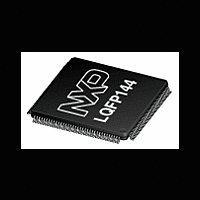LH75401_LH75411_N NXP Semiconductors, LH75401_LH75411_N Datasheet - Page 28

LH75401_LH75411_N
Manufacturer Part Number
LH75401_LH75411_N
Description
The NXP BlueStreak LH75401/LH75411 family consists of two low-cost 16/32-bit System-on-Chip (SoC) devices
Manufacturer
NXP Semiconductors
Datasheet
1.LH75401_LH75411_N.pdf
(63 pages)
LH75401/LH75411
UART 2 FEATURES
• Similar functionality to the industry-standard 82510
• Supported baud rates up to 3,225,600 baud (given a
• 5, 6, 7, 8, or 9 data bits per character
• Even, odd, HIGH, LOW, software, or no parity-bit
• 3/4, 1, 1-1/4, 1-1/2, 1-3/4, or 2 stop-bit generation
• µLAN address flag
• Full-duplex operation
• Separate transmit and receive FIFOs, with program-
• Two 16-bit baud-rate generators.
• One interrupt that can be triggered by transmit and
• Generation and detection of breaks during UART
• Support for local loopback, remote loopback, and
• µLAN Address Mode.
Timers
16-bit timers. The timers are clocked by the system
clock, but have an internal scaled-down system clock
that is used for the Pulse Width Modulator (PWM) and
compare functions.
scaled counter clock or external clock and can gener-
ate an overflow interrupt. All three timers have separate
internal prescaled counter clocks, with either a com-
mon external clock or a prescaled version of the sys-
tem clock.
• Timer 0 has five Capture Registers and two Com-
• Timer 1 and Timer 2 have two Capture and two Com-
and can generate an interrupt. The Compare Registers
can force the compare output pin either HIGH or LOW
upon a match.
28
system clock of 51.6096 MHz)
generation and detection
mable depth (1 or 4). Each FIFO has overrun protec-
tion and:
receive FIFO thresholds, receive errors, control
character or address marker reception, or timer
timeout
transactions
auto-echo modes
pare Registers.
pare Registers each.
– Programmable receive trigger levels: 1/4, 1/2,
– Programmable transmit trigger levels: empty, 1/4,
The LH75401/LH75411 microcontrollers have three
All counters are incremented by an internal pre-
The Capture Registers have edge-selectable inputs
3/4, or full
1/2, 3/4.
NXP Semiconductors
Rev. 01 — 16 July 2007
Controller Area Network (CAN)
Timer Compare Registers associated with a timer to
create a PWM. Each timer can generate a separate
interrupt. The interrupt becomes active if any enabled
compare, capture, or overflow interrupt condition
occurs. The interrupt remains active until all compare,
capture, and overflow interrupts are cleared.
Real Time Clock (RTC)
the APB. The RTC provides basic alarm functions or
acts as a long-time base counter by generating an inter-
rupt signal after counting for a programmed number of
cycles of an RTC input. Counting in 1-second intervals
is achieved using a 1 Hz clock input to the RTC.
RTC FEATURES
• 32-bit up-counter with programmable load
• Programmable 32-bit match Compare Register
• Software-maskable interrupt that is set when the
peripheral that connects as a slave to the APB. The
CAN Controller is located between the processor core
and a CAN Transceiver, and is accessed through the
AMBA port.
maximum frequency of 1 MB/s, using the TX (transmit)
and RX (receive) lines. The TX and RX signals for data
transmission and reception provide the communications
interface between the CAN Controller and the CAN bus.
All peripherals share the TX and RX lines, and always
see the common incoming and outgoing data.
specifications. The bus is always controlled by the
node with the highest priority (lowest ID). Only after the
bus has been released can the next highest priority
node control it. Transmit and receive errors are han-
dled according to the CAN protocol.
the CAN Controller has two programmable Bus Timing
Registers that define timing parameters.
NOTE: The CAN Controller pertains to the LH75401 microcontrol-
Counter and Compare Registers have identical values.
The timers support a PWM Mode that uses the two
The RTC is an AMBA slave module that connects to
The CAN 2.0B Controller is an AMBA-compliant
CAN communications are performed serially, at a
Bus arbitration follows the CAN 2.0A and CAN 2.0B
Bus timing is critical to the CAN protocol. Therefore,
lers.
Preliminary data sheet
System-on-Chip














